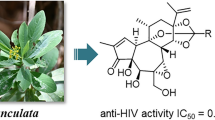Abstract
A mixture oftrans-2-hexenal;n-tridecane (60:40, w/w), the natural combination present in the defensive secretion ofCoridius janus (Hemiptera; Pentatomidae) was shown by comparison with similar aldehyde mixtures having longer and shorter chainn-alkanes, to be the optimal combination as a fumigant and a repellent against three test insect species,Anoplolepis longipes, Sitotroga cerealella, andCulex quinquefasciatus. Toxic values obtained for the three insects, respectively: 1/LC50, 1.72, 4.54, and 6.66 ppm while repellencies were 63%, 50%, and 69%. This study revealed that amongt-2-hexenal:n-alkane combinations those with medium carbon chains,viz C-11 and C-12, also possessed high toxicities and repellencies comparable to that of the natural combination while those with shorter and longern-alkanes possessed lower activity. Toxicities and repellencies ofn-alkane series were only moderate to low showing highest toxic values forn-tridecane at 1/LC50, 0.39, 2.32, and 2.32 ppm and repellencies at 31%, 30%, and 32% for the three test insects, respectively. This series, nevertheless, showed similar variation, medium length chains, C-11, C-12, and C-13 showing comparatively higher activity than other alkanes of shorter and longer chains. This study also revealed that the fumigant property of both alkane and aldehyde are of equal importance while repellency is heavily dependent on the aldehyde.
Similar content being viewed by others
References
Aldrich, J.R. 1988. Chemical ecology of the HeteropteraAnnu. Rev. Entomol. 33:211–238.
Aldrich, J.R., Kochansky, J.P., Lusby, W.R., andSereton, J.D. 1984. Semiochemicals from predaceous stink bug,Podisus maculiventris, J. Wash. Acad. Sci. 74(2):39–46.
Aldrich, J.R., Lusby, W.R., andKochansky, J.P. 1986. Identification of a new predaceous stink bug pheromone and its attractiveness to the eastern yellow jacket.Experientia 42(5):583–585.
Blum, M.S. 1964. Insect defensive secretions; hex-2-enal-1 inPelmatosilpha coriacea and its repellent values under natural conditions.Ann. Entomol. Soc. Am. 57:600–602.
Dettner, K. 1984. Isopropylesters as wetting agents from the defensive secretion of the rove beetle,Coprophilus striatulus F. (Coleoptera; Staphylinidae).Insect Biochem. 14:383–390.
Eisner, T., Meinwald, J., Monro, A., andGhent, R. 1961. Defense mechanisms of Arthropods I, the composition and function of the spray of the whipscorpion,Mastigoproctus giganteus Lucas (Arachnida, Pedipalpia),J. Insect Physiol. 6:272–298.
Gunawardena, N.E., andHerath, H.M.W.K.B. 1991.t-2-Hexenal/n-tridecane combination; A natural fumigant of the defensive secretion ofCoridius janus (Hemiptera; Pentatomidae)J. Nat. Sci. Council, Sri Lanka. Accepted for publication.
Kathuria, O.P., Brown, W.V., andGilby, A.R. 1975. The defense secretion ofApongopus janus (Fabricius), Hemiptera; Pentatomidae,Indian J. Entomol. 36:31–33.
Peschke, K. andEisner, T. 1987. Defensive secretion of the tenebrionid beetle,Blaps mucronata; physical and chemical determinants of effectiveness,J. Comp. Physiol., A 161:377–388.
Prestwich, G.D. 1976. Composition of the scent of eight East African hemipterans, nymph-adult chemical polymorphism in coreids.Ann. Entomol. Soc. Am. 69:812–814.
Remold, H. 1962. Scent glands of land bugs, their physiology and biological function.Nature 198:764–768.
Roth, L.M., Niegisch, W.D., andStahl, W.H. 1956. Occurrence of 2-hexenal in the cockroach,Eurycotis floridana, Science 123:670–671.
Staddon, B.W. 1979. The scent glands of Heteroptera.Adv. Insect Physiol. 14:351–418.
Taketoshi, I. 1974. The scent of stink bugs (Hemiptera: Pentatomidae).Appl. Entomol. Tool. 9:153–158.
Weatherston, J. 1967. The chemistry of arthropod defense substances.Quarterly Rev. 21:287–300.
Weatherston, J., andPercy, J.E. 1978. Venoms of Rhyncota,in S. Bettini (ed.). Arthropod Venoms. Springer, Verlag Berlin/Heidelberg.
Author information
Authors and Affiliations
Rights and permissions
About this article
Cite this article
Gunawardena, N.E., Herath, H.M.W.K.B. Significance of medium chainn-alkanes as accompanying compounds in hemipteran defensive secretions: An investigation based on the defensive secretion ofCoridius janus . J Chem Ecol 17, 2449–2458 (1991). https://doi.org/10.1007/BF00994593
Received:
Accepted:
Issue Date:
DOI: https://doi.org/10.1007/BF00994593




